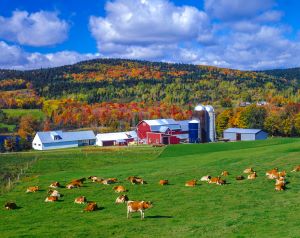THURSDAY, DECEMBER 15, 2022
If you are a crop farmer, crop production is essential in order to turn a profit. However, dealing in agricultural commodities, crops in particular, is a very high-risk business. It’s very easy for crops to get destroyed, and if they do, then they could represent a significant financial loss.

To help yourself withstand the ramifications of crop loss, you should be certain to include crop insurance among your farm’s insurance benefits. It’s property coverage that, while unique to the agricultural industry, is still essential for any crop producer, processor or storer. Here’s how it works.
The Basics of Crop Insurance
At its simplest, crop insurance provides compensation to the farm if crops are lost or destroyed due to certain incidents. Covered incidents often include:
- Fire
- Hail
- Lightning
- Smoke
- Theft
- Vandalism
- Drought
Additionally, your policy will offer you income replacement coverage, which will help you when you have to stop production due to incidents beyond your control. For example, if you experience price drops or government mandates to destroy crops, then you will have coverage for those losses.
However, not all crop insurance policies are created equal. There are many different types of crop insurance, and you’ll need to choose the appropriate one in order to receive the most appropriate benefit for your specific operations.
There are two main types of crop insurance policies:
- Crop-Hail Policies: May be purchased through a private insurer at any point in the season, and will protect your crops against hail.
- Multiple Peril Crop Insurance: Only select insurers are able to offer these policies through the Federal Crop Insurance Program. This policy covers crops against a range of threats, such as excessive moisture and freezes. This insurance must be purchased before the crops are planted.
When you have to file a claim, you will contact your insurance provider who will send an underwriter to investigate. Once the claim is approved, you will receive compensation for crops that have been lost or damaged, and you may receive temporary revenue assistance.
What Does Crop Insurance Cost?
Like all insurance policies, crop insurance will come at a cost. However, various factors might influence your precise premium, including the:
- Location of the farm
- Size of the property and your crop yield
- Type of crops being grown
- Harvesting season
What’s important to do is to be upfront with your agent about your goals for your operations. Ensure that they know the size and value of your crop production, and exactly how much money you will stand to lose if crops get destroyed.
Additionally, don’t forget to determine how best to integrate your crop coverage with the rest of your farm’s insurance benefits. You will need coverage for your farm buildings, livestock and equipment, not to mention liability benefits, employee benefits and workers’ compensation insurance if applicable.
No matter what you grow or where you grow it, crop insurance can protect your agricultural business from heavy financial loss. Calculate the value of your crops and find the right policy.
No Comments
Post a Comment |
|
Required
|
|
Required (Not Displayed)
|
|
Required
|
All comments are moderated and stripped of HTML.
|
|
|
|
|
|
NOTICE: This blog and website are made available by the publisher for educational and informational purposes only.
It is not be used as a substitute for competent insurance, legal, or tax advice from a licensed professional
in your state. By using this blog site you understand that there is no broker client relationship between
you and the blog and website publisher.
|
Blog Archive
|